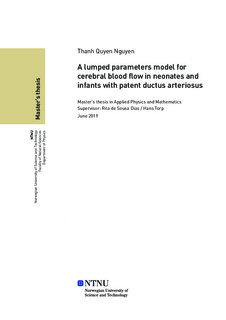| dc.contributor.advisor | Rita de Sousa Dias, Hans Torp | |
| dc.contributor.author | Thanh Quyen Nguyen | |
| dc.date.accessioned | 2019-10-26T14:04:38Z | |
| dc.date.available | 2019-10-26T14:04:38Z | |
| dc.date.issued | 2019 | |
| dc.identifier.uri | http://hdl.handle.net/11250/2624695 | |
| dc.description.abstract | En lumped parametermodell er utviklet for a ̊ studere dynamikken til en pulserende strømning i et sirkulasjonssystem, inkludert det cerebrale vaskulære nettverket. Denne modellen ble utviklet fra en forenklet anatomisk konfigurasjon og representert av en ekvi- valent elektrisk krets, hvor hvert elektrisk element representerer en spesifikk egenskap av sirkulasjonssystemet. Ma ̊let var a ̊ simulere den cerebrale blodstrømmen hos spedbarn med og uten patent ductus arteriosus, en hjertesykdom som rammet mange spedbarn, spesielt premature spedbarn.
I tillegg til simuleringene ble ogsa ̊ cerebralt blodstrøm opptak gjennomført i samarbeid med Nyfødtintensiv pa ̊ St. Olavs Hospital. Ma ̊lingene ble utført med Neodoppler, et rela- tivt nytt ultralydssystem utviklet av Professor Hans Torp og Ultralydgruppen ved Institutt for sirkulasjon og medisinsk bildediagnostikk, NTNU. Disse opptakene brukes ba ̊de til a ̊ estimere modell parametrene og for a ̊ validere resultatene.
Til tross for en enkel tilnærming, var den implementerte modellen i stand til a ̊ imitere den typiske bølgeformen i ba ̊de trykket og strømmen for cerebral arterien og andre seg- menter av sirkulasjonssystemet. En serie simuleringer har ogsa ̊ blitt utført for a ̊ vurdere forbindelsen mellom ductus arteriosus (DA) og distribusjon av blodstrøm og trykk og hvor- dan de reguleres. Resultatene viste at lukking av DA involvert andre reguleringsmekanis- mer for a ̊ opprettholde et optimalt blodtrykk niva ̊. Modellen kan utvides til a ̊ inkludere disse dynamiske reguleringsmekanismer, men var begrenset av systemets kompleksitet og begrensninger av simuleringsverktøyet. | |
| dc.description.abstract | A lumped parameters model have been developed to study the dynamics of pulsatile flow in a cardiovascular system (CVS), including the cerebral vascular network. This model was developed from a simplified anatomical configuration and represented by an equivalent electric circuit, where each electric element represents a specific characteristic of the CVS. The aim was to simulate the cerebral blood flow in infants with and without patent ductus arteriosus, a heart condition that affected many infants, especially preterm infants.
In addition to the simulations, cerebral blood flow recordings were also carried out in collaboration with the Neonatal Intensive Care Unit at St. Olavs Hospital. The measure- ments were performed with Neodoppler, a relatively new ultrasound system developed by Professor Hans Torp and the Ultrasound Group at the Department of circulation and medi- cal imaging, NTNU. These recordings are used both to estimate the model parameters and to validate the results.
Despite a simple approach, the implemented model was able to imitate the typical waveform in both the pressure and flow for the cerebral artery and other segments of the CVS. A series of simulations have also been conducted to assess the connection between the ductus arteriosus (DA) and the distribution of flow and pressure and how they are regulated. The results indicated that the closure of DA involved other regulatory mecha- nisms in maintaining an optimal level of pressure. The model can be expanded to include these dynamics regulations but was limited by the complexity of the overall effects and limitations of the simulation tool. | |
| dc.language | eng | |
| dc.publisher | NTNU | |
| dc.title | A lumped parameters model for cerebral blood flow in neonates and infants with patent ductus arteriosus | |
| dc.type | Master thesis | |
